Long Island Cicadas is a blog about cicadas created and maintained by artist & photographer Annette DeGiovine.
Annette is a fantastic photographer and citizen scientist.
Here’s a sample of the articles on the blog.
Long Island Cicadas is a blog about cicadas created and maintained by artist & photographer Annette DeGiovine.
Annette is a fantastic photographer and citizen scientist.
Here’s a sample of the articles on the blog.
This is a Neotibicen latifasciatus (Davis, 1915) commonly known as the Coastal Scissor Grinder, locally known as a Yodeling Cedar Sucker in Florida and Beach Banshee in North Carolina 3:
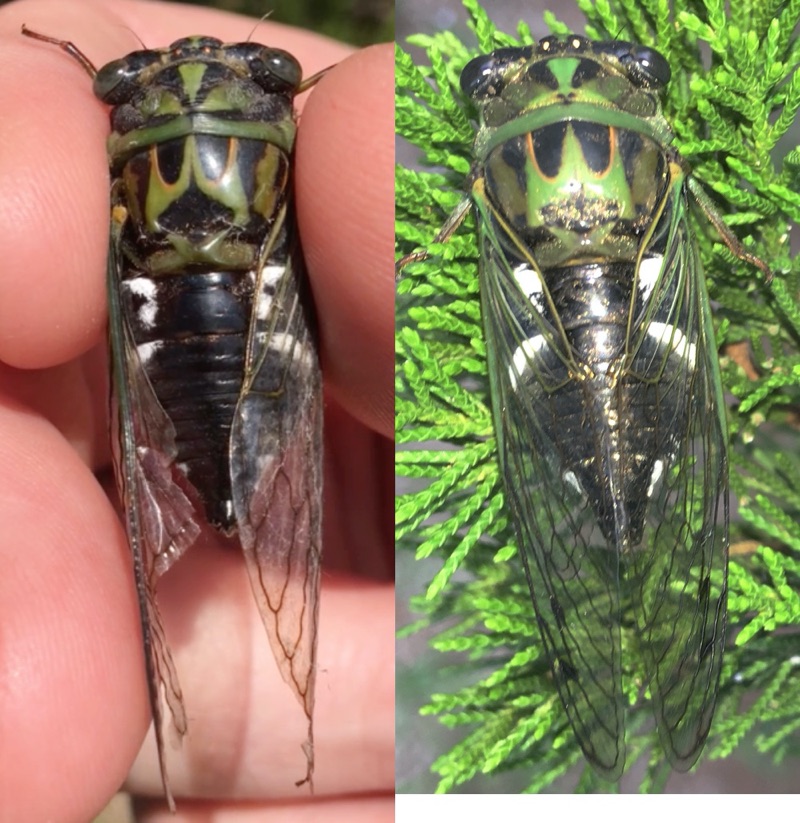
The holotype — a single type specimen on which the description of a new species is based — for the cicada Neotibicen latifasciatus was gathered from Cold Spring, Cape May County1. I feel that N. latifasciatus needs a common name indicative of Cape May, New Jersey. Here are my ideas:
The last one is my favorite (changed it to South ;))
N. latifasciatus is a cicada found along the east coast of the United States, and is known for its preference for cedar trees. It can be found in New Jersey, Maryland, North Carolina, Virginia2, Florida and points in between3. Its affinity for cedar trees (plus its distinct call) makes it relatively easy to locate and capture — if you’re willing to get a little messy climbing through the thick & sticky branches of a cedar tree. A thin mist of sap from the cedar seems to coat the wings of these cicadas, and it’s worth mentioning that their wings are often torn and ragged, probably resulting from the thick cedar foliage.
When William T. Davis first described N. latifasciatus in 19154, he described it as a variety of Cicada pruinosa (now Neotibicen pruinosus pruinosus). This is understandable, since they sound very much alike, and look alike except for the the white bands on the sides of the latifasciatus, some other minor morphological differences, and habitats. pruinosus, latifasciatus, winnemanna, linnei, canicularis, and robinsonianus are collectively known as the Green [Neo]tibicen Species3 or simply “the Green Group”.They’re called Green because much of their heads, collars, pronotums and mesonotums are green in color.
On Saturday, August 20th, 2016, I met Elias Bonaros and Annette DeGiovine-Oliveira in Middle Township, Cape May County to search for latifasciatus. I arrived before they did and located a relatively quiet road lined with cedar trees, filled with screaming latifasciatus. From the outside cedars resemble twisting green fire; on the inside they’re a mess of tightly-packed, dirty branches — perfect for an insect to hide. The road and trees were surrounded by briny marshland, less than a mile from the Atlantic Ocean. Other than cicadas, there were an abundance of annoying greenhead flies (Tabanus nigrovittatus), and not annoying at all katydids. The temperature was in the mid 80s, the air was humid, the sun was brutal, and the flies thought I was delicious. In the 5 hours we spent photographing and gathering specimens, I drank a gallon of water. Elias handled cicada procurement duties, and Annette and I recorded the cicadas’ song and habitat.
Here’s a video summary of our adventure:
After a satisfying lunch, I went looking for other locations and found a very different but prime in-land location with taller cedar (Red and White varieties) in Woodbine Borough. There we found many exuvia, which we did not find at the other location, and heard not only latifasciatus, but also N. linnei, N. tibicen tibicen, N. canicularis, and N. auletes. Around 9pm, and almost 12 hours of cicada field-work, I called it quits. Elias and Annette stuck around and were able to observe molting latifasciatus.
The ventral side a male Neotibicen latifasciatus:
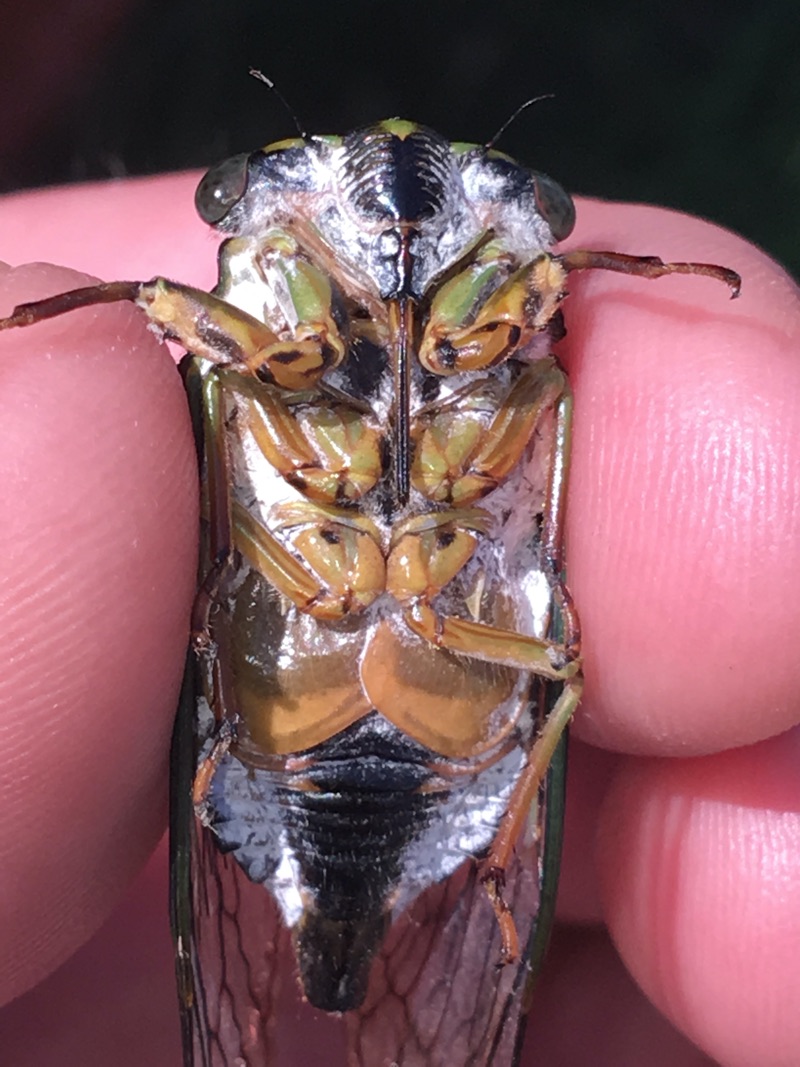
This cicada was captured using the “clap” method of netting cicadas. This method involves two people using two nets, surrounding the cicada so it can’t find an escape path.
I would be remiss if I did not mention how delightful the people of Cape May County are. All the folks we encountered were pleasantly curious or encouraging about our cicada research activities. They also have “Custard” shops instead of Ice Cream shops.
Also check out Annette’s YouTube channel for video of the latifasciatus habitat and song.
1 Sanborn AF, Phillips PK. 2013. Biogeography of the Cicadas (Hemiptera: Cicadidae) of North America, North of Mexico. Diversity 2013, 5, 166-239.
2 Sanborn AF, Heath MS. 2012. The Cicadas (Hemipetera: Cicadoidea: Cicadidae) of North America North of Mexico. Entomological Society of America. 45.
3 BugGuide Species Neotibicen latifasciatus page.
4 Davis WT. 1915a. Notes on some cicadas from the eastern and central United States with a description of a new variety of Cicada pruinosa. Journal of the New York Entomological Society 23: 1—10. (see the North American Cicadas page)

Since 2013 I’ve met Elias Bonaros and Annette DeGiovine in Manchester, New Jersey to search for the cicada Neotibicen auletes. It has become an annual tradition.
M. auletes is the largest cicada in the Americas, they have a particularly arresting call, and are a beautiful lime green when recently molted. They are definitely worth taking the time to find.
Locating and observing cicadas in northern States can be particularly vexing because they are far less abundant, and much of their habitat has been eliminated to make way for the ever-growing, densely-packed human population. It is a treat any time we can find and observe a living cicada specimen up-close. If you’re the type who likes to travel to observe cicadas, New Jersey is not a great place to start on the east coast. Southern states, starting at North Carolina to Florida are your best bets, in terms of species diversity and abundance. If you’re a collector, be aware of local laws — for instance, collecting in Florida is completely forbidden.
This year’s adventure began around 7:15pm when I arrived at the mini-mall where Caballero’s Pizzeria is located (Manchester, NJ on Route 70). Part of the tradition is to have a few slices of pizza, and after four years the owner knows who we are. The mini-mall the pizzeria is located in is bordered on the right by a sandy-soil pine & oak forest, and in front by two small groves of tall oaks & pines. Oddly, the ground of these groves has been covered with a back mesh tarp, which completely prevents underbrush growth. This doesn’t seem to deter cicadas from emerging, but I’m skeptical that future generations of cicadas will find the smaller plant roots they need during the early stages of life.
At 7:15pm the small and beautiful Neocicada hieroglyphica cicadas were singing from many trees in groves and forest (they would continue singing to around 9pm, well past sunset). Around 7:30pm Neotibicen linnei began to join them.
Elias and Annette arrived shortly before sunset, around 8pm, giving them time and daylight to scout the grounds for deceased adult specimens and exuvia (molted skins); oddly none were found. Neotibicen auletes calls at dusk, right after sunset. On queue multiple N. auletes began calling from the trees in the groves and forest, like a soloist overpowering the lesser vocalists and instruments around him, N. auletes are the divas of the New Jersey cicada opera.
Elias photographing an auletes:
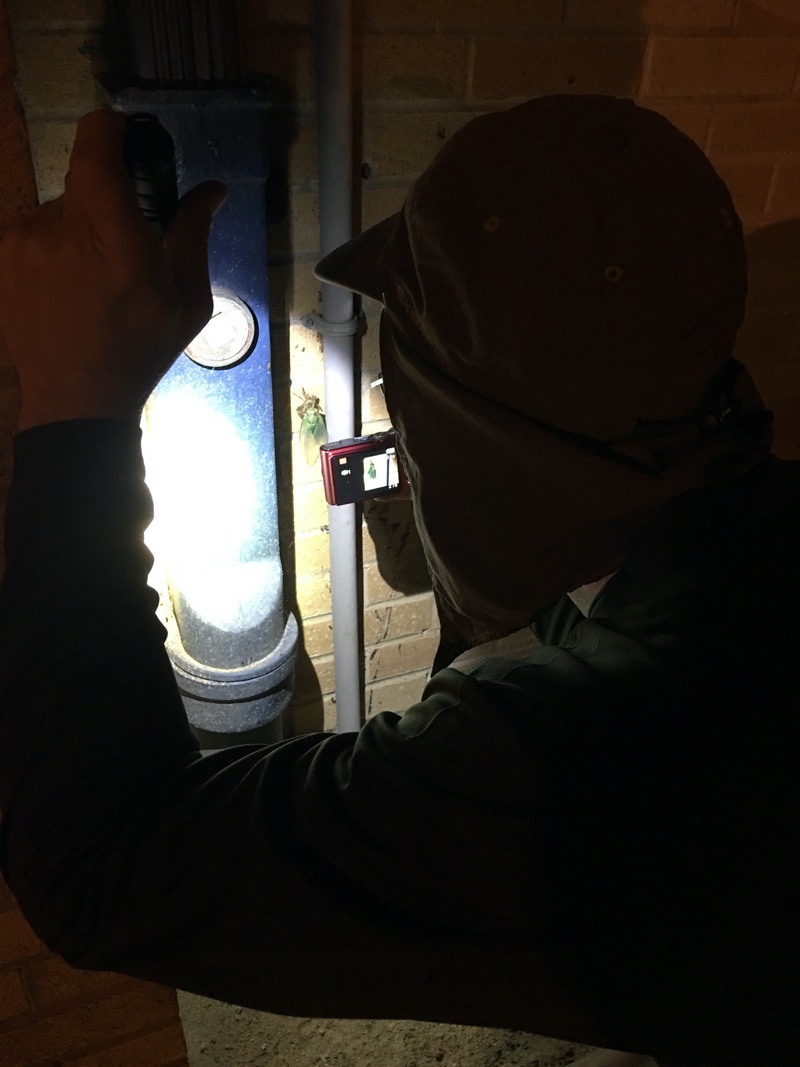
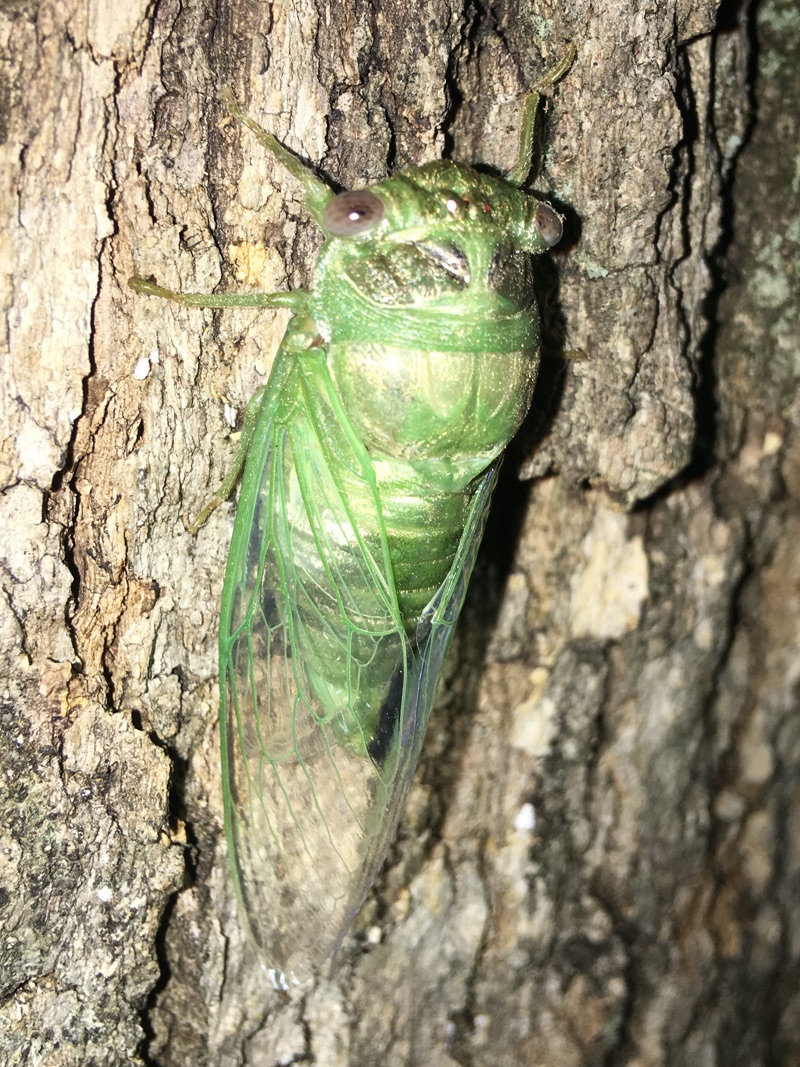
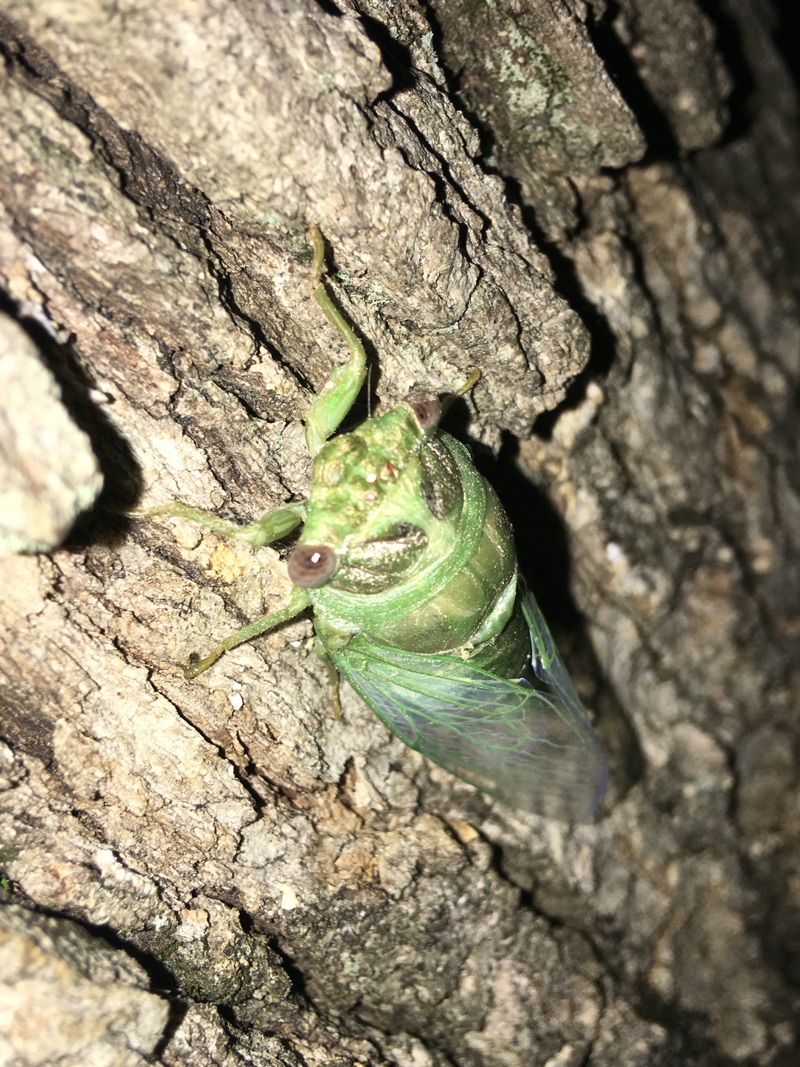
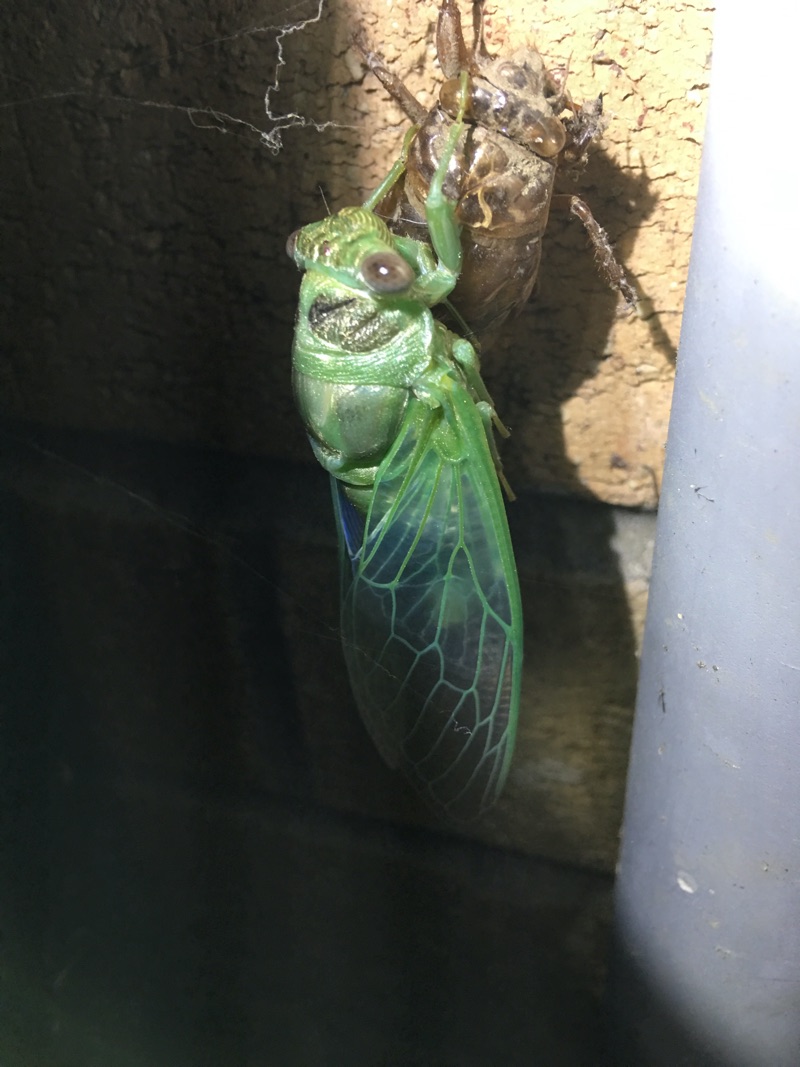
No exuvia or dead N. auletes was found, but the many calls we heard were encouraging. Once night fell we began to search the local area for emerging nymphs and molting adults. After a long search Elias found a single female auletes molting on the side of a school. Three hours of searching only yeilded one cicada — for those who have experienced periodical cicada emergences, or those who live in areas with an abundance of annual species, a lone cicada would be very disappointing. For Elias, Annette and I, finding a lone (locally) rare cicada, was not disappointing at all.
The funniest moment of the night came when a local policeman asked us if we were hunting Pokemon! Of course we were not — we were hunting cicadas. A little harder to explain, and probably more fun.
Video from the trip:
Previous Manchester NJ auletes adventures:
Elias Bonaros shared this photo of a Neocicada hieroglyphica that he observed emerging in Riverhead, Long Island, New York, which is the north-most point of their range, as documented by William T. Davis.
They were taken today, July 13th, 2015.
Here is the Neocicada hieroglyphica hieroglyphica exiting its nymphal skin.


Annette DeGiovine wrote an extensive blog post with many images and video of emerging Neocicada hieroglyphica. Check it out.
Last night I went on an exploration of Manchester, NJ looking for Megatibicen auletes (Germar, 1834) with Elias Bonaros and his friend Annette.
M. auletes, are known as the Northern Dusk Singing Cicada. As their name suggests, M. auletes calls at dusk, around sunset. Their call is amazing – visit Insect Singers to hear their call.
Luckily I found a (deceased) female and an exuvia (nymph skin). Elias and Annette found many exuvia and a live nymph. We were able to watch the nymph undergo ecdysis (leave its exuvia, and expand its adult body).
Here are some images of the cicadas we found last night (click the first two images to get to larger versions):
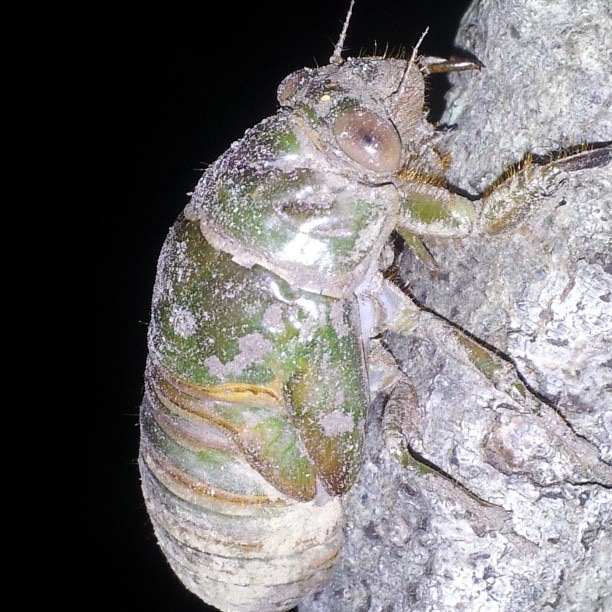
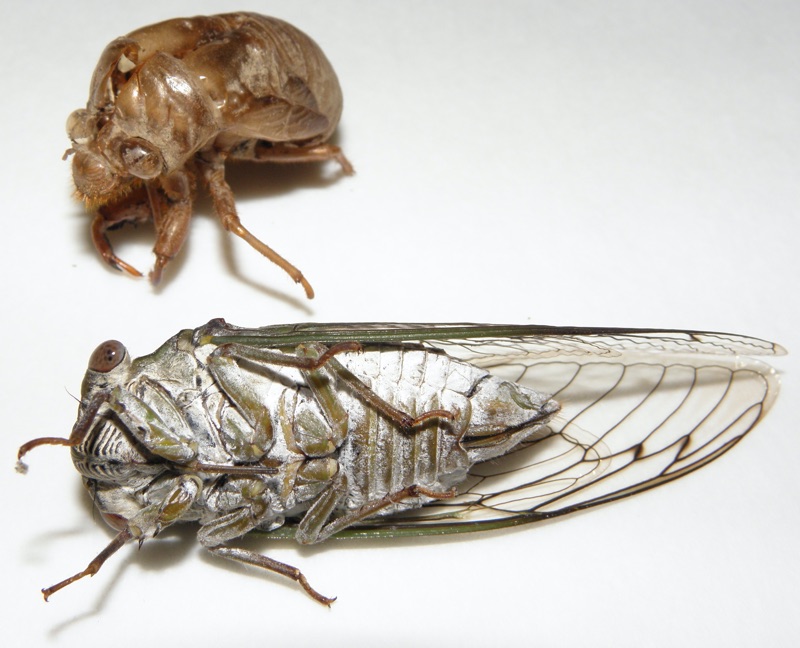
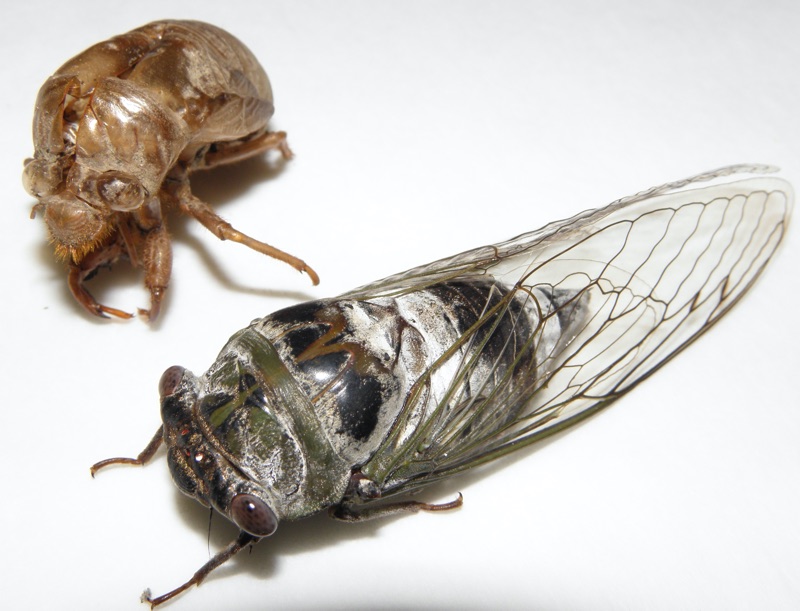
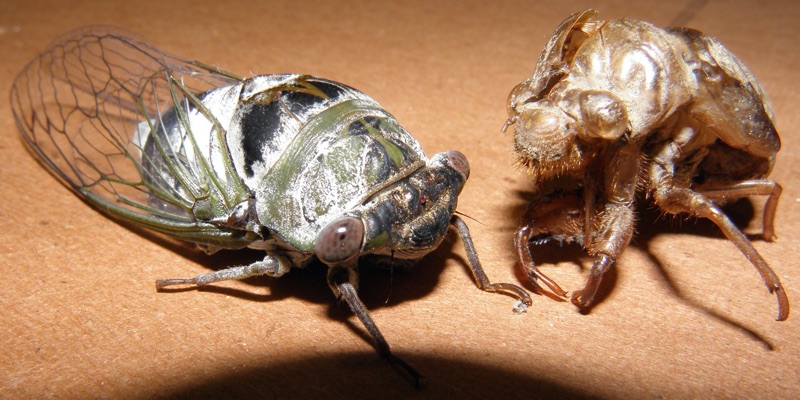
Some (blurry) video:
Dan and Elias netting a M. auletes exuvia. Photo by Annette DeGiovine-Oliveira:

* Note as of 2023 the name of this cicada has changed to Megatibicen grossus. You can also call it a Northern Dusk-Signing Cicada.